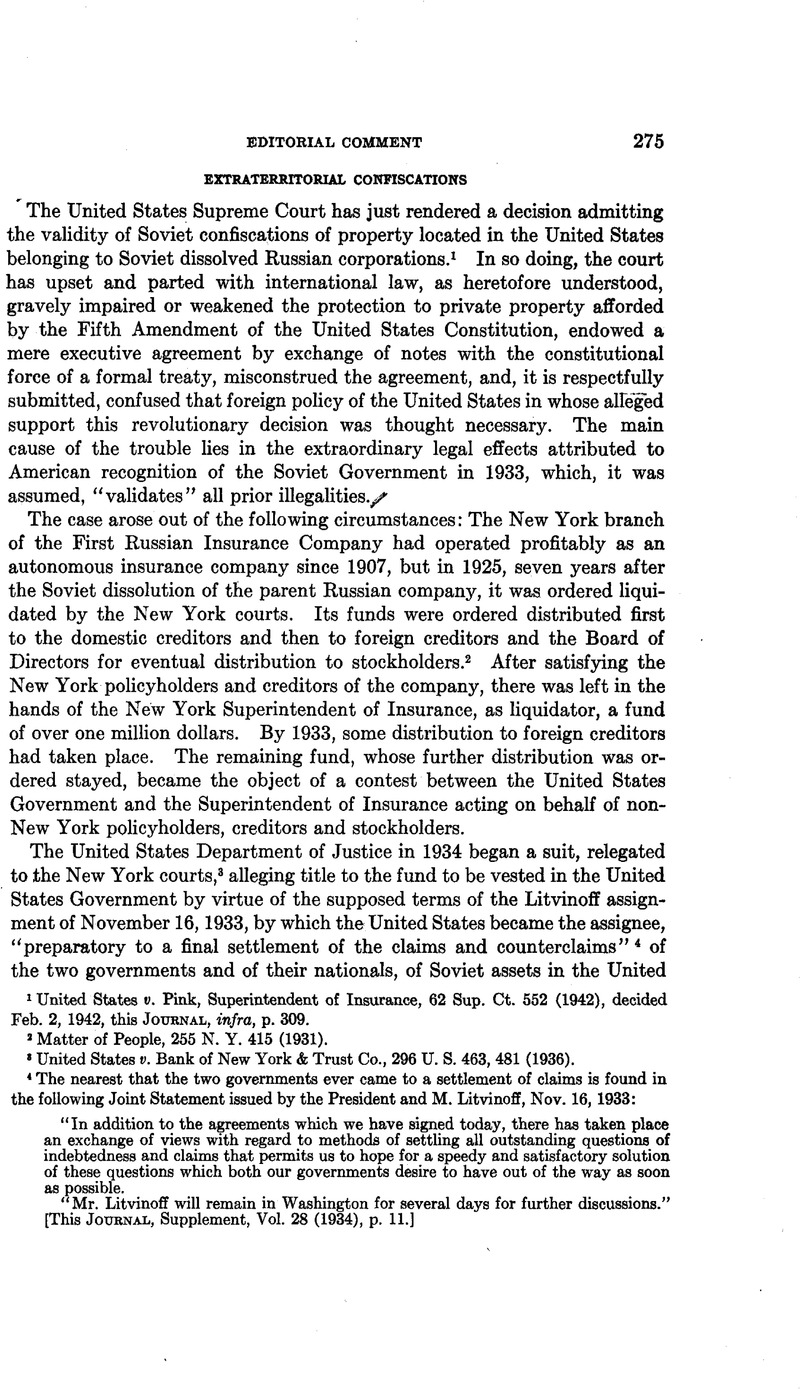No CrossRef data available.
Published online by Cambridge University Press: 12 April 2017

1 United States v. Pink, , Superintendent of Insurance, 62 Sup. Ct. 552 (1942), decided Feb. 2, 1942, this Journal, infra, p. 309.Google Scholar
2 Matter of People, 255 N. Y. 415 (1931).
3 United States v. Bank of New York & Trust Co., 296 U. S. 463, 481 (1936).Google ScholarPubMed
4 The nearest that the two governments ever came to a settlement of claims is found in the following Joint Statement issued by the President and Litvinoff, M., Nov. 16, 1933:Google Scholar
“In addition to the agreements which we have signed today, there has taken place an exchange of views with regard to methods of settling all outstanding questions of indebtedness and claims that permits us to hope for a speedy and satisfactory solution of these questions which both our governments desire to have out of the way as soon as possible.
“Mr. Litvinoff will remain in Washington for several days for further discussions.”[This Journal, Supplement, Vol. 28 (1934), p. 11.]Google ScholarPubMed
5 The Roosevelt-Litvinoff exchange of notes is printed in this journal, Supplement, Vol. 28 (1934), pp. 1–11.
6 Lehigh Valley, R. R. v. State of Russia, 21 F. (2d) 396, 401 (1927), cert. denied, 275 U. S.571 (1928).Google Scholar
7 282 U. S. 481 (1931).
8 The claim arising out of the United States expedition against Siberia was separately waived by the Soviet Government.
9 Connick in (1925) 34 Yale L. J. 499; Borchard, this Journal, Vol. 31 (1937), p. 675; Jessup, ibid., p. 481; see also Guaranty Trust Co. v. United States, 304 U. S. 126 (1938),this Journal, Vol. 32 (1938), p. 848; United States v. Moscow Fire Ins. Co., 280 N. Y. 286(1939), 309 U. S. 624 (1940).
10 United States Belmont, v., 301 U. S. 324 (1937); this Journal, Vol. 31 (1937), p. 537;51 Rev, Harv. L.. 162, 47 Yale, L. J. 292.Google Scholar
11 Cf. Nebolsine in 39 Yale L. J. 1130 (1930).
12 Supra, n. 9.
13 Salimoff & Co. v. Standard Oil Co., 262 N. Y. 220 (1933); Vladikavkazsky Ry. Co. v.N. Y. Trust Co., 263 N. Y. 369 (1934). E. G. Lorenzen, "Territoriality, Public Policy and the Conflict of Laws" (1924), 33 Yale L. J. 736, 748 et seq. Our courts would not even enforce foreign penal and tax laws.
14 53 Stat. L. 1199 (Aug. 4, 1939).
15 Supra, n. 4.
16 It seems strange for Justice Douglas to assume that the proceeds of such Russian-American confiscations could make the United States and its nationals “whole” (Opinion, p. 14), 62 Sup. Ct. 552 at 565.
17 The Belmont case (Supra, n. 10) had held that the United States had a cause of action arising out of the Litvinoff assignment, but left open the question whether the assignment to the United States would prevail over adverse claims of private creditors orowners. This question the Pink case decided in the affirmative. Because the Belmont case had not so decided, Chief Justice Stone, dissenting, considered the Belmont case asnot determinative of the present issue.
18 In its brief in that case the United States had argued (p. 32) that the recognitionof Russia in the executive agreement “retroactively validates the acts of the government recognized from the time of its inception.” See W. B. Cowles,“Treaties and Constitutional Law: Property Interferences and Due Process of Law,” Washington, 1941, p. 279. Justice Sutherland had assumed this error to be a fact in the Belmont case, and it wasquoted as gospel by Justice Douglas in the Pink case.
19 United States v. Belmont, 301 U. S. at 328; United States v. Pink, Supra, n. 1, at p. 562.
20 (1937) 50 Harv. L. Rev. 395 at 431.
21 246 U. S. 297 (1918); this Journal, Vol. 12 (1918), p. 421.
22 Supra, n. 20.
23 Fischer v. American United Life Ins. Co., 62 Sup. Ct. 380 (1942), decided Jan. 5, 1942. Clark v. Williard, 294 U. S. 211 (1935).
24 Cases cited and discussed in Lorenzen, Supra, n. 13.
25 8 Cranch 110 (1814).
26 United States v. Percheman, 2 Peters 51 (1833).
27 Cf. Wallace McClure, International Executive Agreements, N. Y. 1941, and review in42 Col. L. Rev. (April, 1942).
28 Disconto Gesellschaft v. Umbreit, 208 U. S. 570 (1908). But Cf. Blake v. McClung,172 U. S. 239 (1898).
29 Cf. C. P. Anderson, this Journal, Vol. 28 (1934>), p. 90. 1 Hackworth’s Digest, 302 et seq. Foreign Relations, 1920, III, 467; ibid., 1923, II, 755, 762, 788.
30 Supra, n. 4.